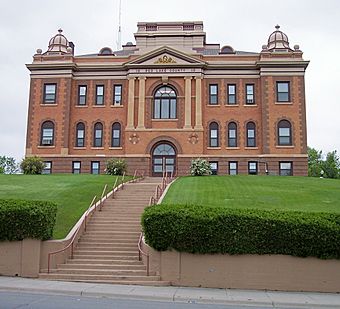Red Lake County Courthouse facts for kids
Quick facts for kids |
|
|
Red Lake County Courthouse
|
|
 |
|
| Location | 124 Langevin, Red Lake Falls, Minnesota |
|---|---|
| Area | less than one acre |
| Built | 1911 |
| Architect | Fremont D. Orff, James Brady |
| Architectural style | Beaux Arts |
| NRHP reference No. | 83000941 |
| Added to NRHP | May 9, 1983 |
The Red Lake County Courthouse is an important building in Red Lake Falls, Minnesota. It's where many local government activities happen for Red Lake County, Minnesota. This beautiful building was finished in 1911. It has a special design called Beaux Arts architecture.
Contents
About the Red Lake County Courthouse
The Red Lake County Courthouse is located at 124 Langevin Avenue in Red Lake Falls, Minnesota. It serves the people of Red Lake County, Minnesota. This building is a key part of the local government. It helps make sure rules are followed and services are provided.
Its Unique Look
The courthouse is made of red bricks. It has a special style called Beaux Arts architecture. This style often includes grand, fancy designs. You can see small domes on each corner of the building. When it was first built, it also had a large dome in the middle. But this bigger dome was taken down in the 1940s.
The front entrance of the courthouse is very grand. It has fake columns on each side. These columns are topped with a classic pediment. A pediment is a triangular shape often seen in old Greek and Roman buildings.
Inside the Building
When you go inside, you'll find an open area called an atrium. This space goes up two stories high. It's like a big open room with a rotunda. A rotunda is a round hall or room. From the second floor, you can look down through arched openings.
Who Designed It?
The Red Lake County Courthouse was designed by two architects. Their names were Fremont D. Orff and James Brady. They finished building it in 1911. The total cost to build this important structure was $37,070.
Why Is It Important?
The Red Lake County Courthouse is more than just a building. It's a place where important decisions are made. It helps the community run smoothly. Because of its special design and history, it was added to the National Register of Historic Places on May 9, 1983. This means it's recognized as a place worth preserving.



